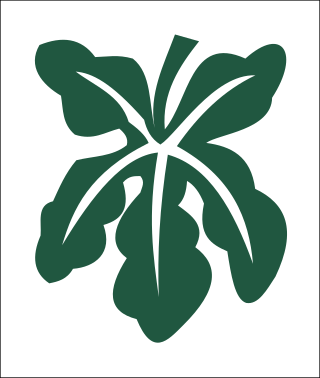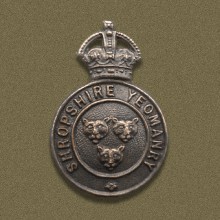
III Corps was an army corps of the British Army formed in both the First World War and the Second World War.

An Army Group Royal Artillery (AGRA) was a British Commonwealth military formation during the Second World War and shortly thereafter. Generally assigned to Army corps, an AGRA provided the medium and heavy artillery to higher formations within the British Army.

1st Army Group Royal Artillery was a brigade-sized formation organised by Britain's Royal Artillery during World War II to command medium and heavy guns. It served in the final stages of the Tunisian Campaign and throughout the Italian Campaign. It reformed in the Territorial Army in the 1950s to command air defence units.

The Shropshire Yeomanry was a yeomanry regiment of the British Army, first raised in 1795, which served as a cavalry and dismounted infantry regiment in the First World War and as a cavalry and an artillery regiment in the Second World War. It was then amalgamated with the Shropshire Royal Horse Artillery.
The Sussex Yeomanry is a yeomanry regiment of the British Army dating from 1794. It was initially formed when there was a threat of French invasion during the Napoleonic Wars. After being reformed in the Second Boer War, it served in the First World War and the Second World War, when it served in the East African Campaign and the Siege of Tobruk. The lineage is maintained by 1 Field Troop, 579 Field Squadron (EOD), part of 101 (London) Engineer Regiment (Volunteers).
In September 1939, the British Army was in process of expanding their anti-aircraft and mobile assets. Among these new changes was the formation of Anti-Aircraft Command which was formed on 1 April 1939, and the 1st Armoured Division formed in 1937. The list below will include the British Army units, colonial units, and those units which were in the process of formation.

The 231st Brigade was an infantry brigade of the British Army that saw active service in both the First and the Second World Wars. In each case it was formed by redesignation of existing formations. In the First World War, it fought in Palestine and on the Western Front, while during the Second World War it served in the Allied invasion of Sicily, Italy and the Normandy landings of 6 June 1944.
The Shropshire Royal Horse Artillery was a Territorial Force Royal Horse Artillery battery that was formed in Shropshire in 1908 from the Shropshire Battery of the 1st Shropshire and Staffordshire Artillery Volunteers, Royal Garrison Artillery of the Volunteer Force. It saw active service during the First World War on the Western Front in 1917 and 1918 as part of an Army Field Artillery Brigade. A second line battery, 2/1st Shropshire RHA, also served on the Western Front in 1917 and 1918 as part of another Army Field Artillery Brigade. It was reconstituted post-war as a medium artillery battery and served as such in the Second World War.
The Berkshire Royal Horse Artillery was a Territorial Force Royal Horse Artillery battery that was formed in Berkshire in 1908. It saw active service during the First World War in the Middle East, notably at Aden and in particular in the Sinai and Palestine Campaign, from 1915 to 1918. A second line battery, 2/1st Berkshire RHA, served on the Western Front in 1917 and 1918 as part of an Army Field Artillery Brigade. After the Armistice, it was reconstituted as a Royal Field Artillery battery of the Territorial Army (TA), later being expanded into a full heavy anti-aircraft (HAA) regiment that served during the Second World War in the Battle of Britain and Blitz, in the assault landings in North Africa, Sicily and Italy. Postwar, it continued in the TA until 1968.

The 86th Field Regiment, Royal Artillery, was a unit of Britain's part-time Territorial Army (TA) formed after World War I from existing artillery and Yeomanry Cavalry units recruited in Hertfordshire. Its self-propelled guns were among the first artillery to land in Normandy on D Day and served throughout the North West Europe campaign in World War II, seeing action in Normandy, at the liberation of Antwerp, in Operations Market Garden, Clipper and Veritable, the Rhine crossing and the advance across Germany. The regiment continued in the postwar TA until 1967, and its successor battery continued to 2014.
The North Midland (Staffordshire) Heavy Battery was a Territorial Force (TF) unit of the Royal Garrison Artillery (RGA) formed in Staffordshire in 1908. It fought on the Western Front during World War I. Converted to medium artillery in the 1920s, the unit took part in the Battle of France and Dunkirk Evacuation in the early part of World War II, before returning to action in North Africa and Italy, and finally in North West Europe.

The 6th Anti-Aircraft Division was an air defence formation created within Anti-Aircraft Command of Britain's Territorial Army just before the Second World War. It defended the Thames Estuary and the approaches to London during the Battle of Britain and the Blitz.
59th Army Group Royal Artillery was an artillery formation of the British Army in World War II. Having operated in the North West Europe theatre in late 1944, it was switched to India to command artillery units preparing for the liberation of South-East Asia.
The 80th Anti-Aircraft Brigade was an air defence formation of the British Army during the Second World War. It landed on D-Day and saw action throughout the campaign in North West Europe, providing early warning of attacks by V-1 flying bombs against Antwerp during the winter of 1944–45.
The 86th Heavy Anti-Aircraft Regiment, Royal Artillery was an air defence unit of Britain's Territorial Army (TA) that served throughout World War II. It defended London during The Blitz, landed on Juno Beach on D-Day, and defended the cities of Belgium against V-1 flying bombs.

The 191st Field Regiment was a unit of Britain's Royal Artillery (RA) formed during World War II. Created around experienced drafts from existing Territorial Army units, it trained as mobile artillery with an armoured division. Later it served through the campaign in North West Europe, supporting varied formations such as the Royal Marine Commandos, Royal Armoured Corps and Polish troops operating under First Canadian Army.

The Edinburgh City Artillery was a part-time unit of Britain's Volunteer Force raised around Edinburgh in 1859. It was the parent unit for a number of batteries in the later Territorial Force, including heavy batteries of the Royal Garrison Artillery that fought on the Western Front during World War I. It later formed a heavy regiment that served in the Battle of France and the campaign in North West Europe during World War II, while a spin-off medium regiment fought in Sicily and Italy. Its successor units continued in the postwar Territorial Army until the 1960s.

2nd Army Group Royal Artillery was a brigade-sized formation organised by Britain's Royal Artillery (RA) during World War II to command medium and heavy guns. It served in the final stages of the Tunisian Campaign and throughout the Italian Campaign. It reformed in the Territorial Army in the 1950s to command air defence units.






